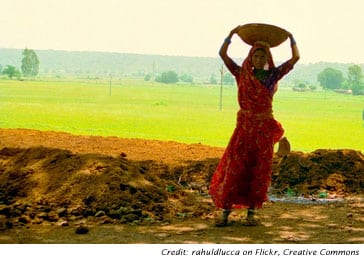
 BALLABGARH, India (Womensenews)–Roopa Rani was a dutiful bride. After marriage, she complied with the custom of waking up at the crack of dawn and accompanying her mother-in-law and sister-in-law to squat in the fields before the men awoke.
BALLABGARH, India (Womensenews)–Roopa Rani was a dutiful bride. After marriage, she complied with the custom of waking up at the crack of dawn and accompanying her mother-in-law and sister-in-law to squat in the fields before the men awoke.
For the rest of the day, no matter how uncomfortable it made them, she and the rest of the women would hold on, no matter how strong the pressure in their bladder and bowels. Relief came only after dark.
Since their houses had no toilets, women and girls–like the men and boys–used nearby fields to relieve themselves. But they could only go at daybreak or after dark, as modesty forbad them from doing so during the daytime, when men could see them. The men were under no such constraint.
But that was two decades ago. Many things have changed since then in Sunper village of Ballabgarh block in the northern state of Haryana.
Today, Rani is determined that her daughter will not face the same ordeal.
"When I got married, there was no toilet in my in-laws’ house in my village. This was not unusual because even before marriage, my mother and I used the fields for defecation. But I know better now and I’m not going to let my daughter continue to use the fields. Unless the family that seeks her hand in marriage has a toilet, there will be no marriage," Rani said.
Rani is joining other women in demanding toilets as a condition for marriage as part of a campaign called "no toilet, no bride." The campaign was launched four years ago via a sanitation push by the federal Ministry of Rural Development, aimed at eradicating the practice of defecating in the open.
Past Sanitation Effort Stymied
In the past, the sanitation effort had been stymied by villagers who lined up for highly subsidized Indian squat toilets–keyhole-shaped bowls that are placed on the ground or elevated platforms, with or without surrounding walls–only to use them as storage containers; they continued to defecate in the open.
State officials partnered with local leaders in a concerted promotional campaign that included radio jingles and posters with mothers saying: "I won’t marry my daughter into a household which doesn’t have a toilet."
"We have come a long way since the time when villagers used the toilets for storage purposes. The people have understood that their health is in their own hands literally. If they use toilets instead of using open fields, they are preventing illness that could be fatal for their children," said Puran Singh Yadav, state project coordinator of the rural development department’s sanitation campaign.
Phulo Devi, 55, a resident of Badhana village in Sonipat district, in the eastern part of the state, says the campaign inspired her to not just ensure her daughter’s husband had a toilet, but she also persuaded her husband to install one in their own house.
"I had no choice but to defecate in the open. But with the government giving us the opportunity to build our own toilet, how could I let it go?" she said.
Her daughter Shamli says no educated young woman wants to marry into a house that has no toilet. "I am educated and know the linkages between lack of hygiene and sanitation and diseases like diarrhea, typhoid, jaundice and malaria. What is the point of being educated if I ignore this when I get married?" she said.
Educating Women Essential
 A basic premise of international women’s rights activism holds that educating women is the single most effective way to achieve development goals and this sanitation campaign among rural women appears to bear that out.
A basic premise of international women’s rights activism holds that educating women is the single most effective way to achieve development goals and this sanitation campaign among rural women appears to bear that out.
"Over 1.71 million toilets have been built across the state," said Neerja Shekhar, director of Census Operations in Haryana. That means almost 98 percent of households now have toilets, a huge gain from 29 percent in 2001.
"It took a lot of hard work to create awareness about sanitation. But we realized getting women on board would make it easier," said Shekhar, who actively promoted the "no toilet, no bride" campaign during her prior tenure as director in the state department of women and child. "We took it village by village. We knew that if we could change one village it would become the model for others."
"Linking sanitation with marriage has worked well," Girija Vyas, chairperson of the National Commission for Women, told Women’s eNews. "In a state which doesn’t give priority to issues like toilets, this strategy has been able to highlight the issue of sanitation and hygiene and underlined its importance for women.
India’s rapidly developing economy is the 12th largest in the world and ranks higher by other macroeconomic criterion, such as purchasing power (fourth) and foreign exchange reserves (fifth).
The toilet-installation push is backed by government funding, with federal money accounting for 60 percent of the initiative and the state 28 percent.
The government asks local communities or individuals to come up with the remaining money to encourage ownership and proper use of toilets.
Swapna Majumdar is based in New Delhi, India, and writes about politics, development and gender.
For more information:
Rural Development Department, Haryana:
http://www.haryanarural.gov.in


